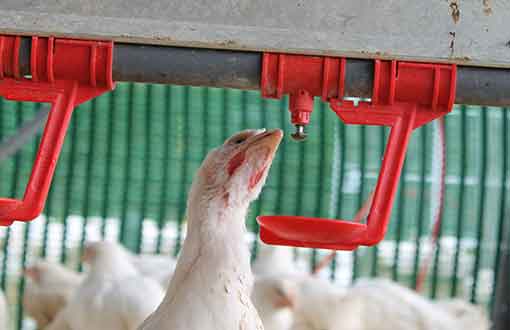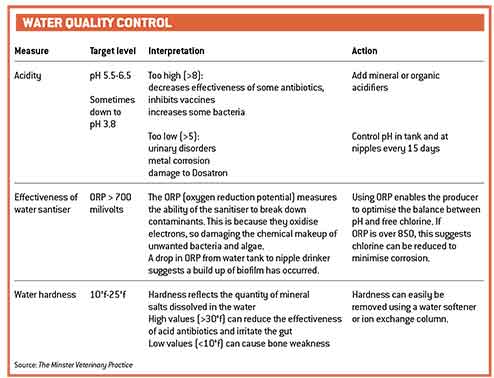How to keep water pure and palatable for poultry

In the past, the addition of chlorine to poultry drinking water has been viewed as a cure-all for just about every ailment that might affect a chicken.
But more modern testing systems have revealed that high levels of bacteria can still persist, even following this treatment.
The efficacy of chlorine is largely dependent on the pH of the water to which it is added, and this makes it an unreliable option, explains specialist poultry vet Alastair Johnston of The Minster Veterinary Practice. The product has also been superseded by other, more effective treatments, he adds.
Biofilm build-up
One of the most important factors in maintaining high water quality is the control of biofilm build-up. This material has a complex carbohydrate structure and can multiply rapidly, especially in places where it is exposed to sunlight. The risk of contamination is particularly great on farms where multi-vitamin treatments are routinely added to the water.
Every effort must be made to minimise biofilm growth, because it provides a framework in which bacteria can multiply, says Mr Johnston. Conventional chlorine will not remove it, but there are products on the market that will tackle both biofilm and bacteria. These include treatments based on chlorine dioxide, hydrogen peroxide and organic acids, all of which are effective, as long as they are applied correctly.
Treatments can be used on a continual or semi-continual basis. A proportioner pump is the best way to achieve this; it will automatically add the chosen product, at the required concentration. This system can also be used for dosing birds with antibiotics or certain vaccines.
Acid levels
A high water pH will reduce the efficacy of a sanitiser, so it may be necessary to introduce an acidifier to the supply, to bring the pH down to around 3.8-4.0 (see table).
Reducing the bacterial count through the acidification of water will help to limit disease and will also keep a better balance of bacteria in food moving through the birds gut. This should result in firmer droppings, which will in turn minimise the problem of wet litter in housing.

Acidifiers contain substances such as formic acid, ascetic acid, propionic acid and hydrogen peroxide; it is advisable to consult your nutritionist to help you select the right product. It may also be necessary to check water pressure, as low pressure may affect the delivery of water treatments. A pump can be installed in cases where pre-set levels are not being achieved.
The hardness or softness of the water is also relevant, as high densities of salts can create limescale build-up, especially in the header tank, lines and drinker cups. This can have an adverse effect on drinker system performance and on treatments such as tetracycline.
The only way to eliminate limescale is by flushing a concentrated acid solution through the system. There have been reports linking hard water to intestinal problems in birds, but there is no evidence to support this theory, says Mr Johnston.
On-farm supplies
Boreholes can be a cost-effective way of providing water on poultry units, but the supply must be tested for bacteria and mineral levels, preferably every six months, he points out.
The quality of borehole water varies greatly and it can also be more unstable, compared with mains water, so it must be monitored closely. Samples should be taken from the source, as well as the end of the drinker lines, to check for contamination in drinker cups or nipples.
There have been cases of birds being poisoned by high levels of nitrates, which are converted to toxic nitrites by gut bacteria, from borehole water. This can happen following heavy applications of slurry or nitrogen fertilisers around the borehole site.
Bird performance can also suffer if borehole water contains high levels of minerals like iron, copper, zinc and lead. These can be toxic and lead to under-performance, or even deaths, and may inhibit the action of vaccines. The removal of minerals can be achieved either by adding a neutraliser before vaccination, or by using a specially-designed filter.
Sampling
To take a representative water sample, the end of line drinker valves should be unscrewed and the water left to flow for a few seconds, before filling a sterile container. Care should be taken to avoid touching the inside of the pot or lid during sampling.
Samples should be submitted for testing as soon as possible, or stored in a refrigerator, to minimise the opportunity for any further bacterial development.
Bacterial contamination is generally measured as a total viable count, or TVC. The aim should be for fewer than 1,000 colonies per millilitre of water.
A more modern method is to use oxygen reduction potential (ORP), to measure water quality. This will reflect the ability of the water to break down contaminants, with threshold levels set at a minimum of 700 millivolts (see table).
Among the newer types of water treatment is UV light, which kills the bacteria as they pass through the system. Another option is ozone, which has had mixed results in tests to date.
If conventional sanitisers are used, they must be added at the correct dose when the birds are housed, because high concentrations of sanitiser can reduce palatability.
Routine treatment
Mr Johnston recommends that flushing water systems with a high concentration treatment between each crop should be standard procedure.
Producers with the traditional bell-type drinkers, which are still used for some free-range flocks, should remove this equipment frequently. It should be soaked in a solution of sanitiser plus an acidifier, to eliminate biofilm and remove harmful pathogens.
Maintaining a clean water supply takes comparatively little time and the price of the additives required has fallen sharply over the past decade, says Mr Johnston. The proportioner pump is a one-off cost and should last for many years, although the interior should be inspected regularly, to check for corrosion.
Attention to this element of poultry management will more than recoup the investment, through improved bird health and performance.
